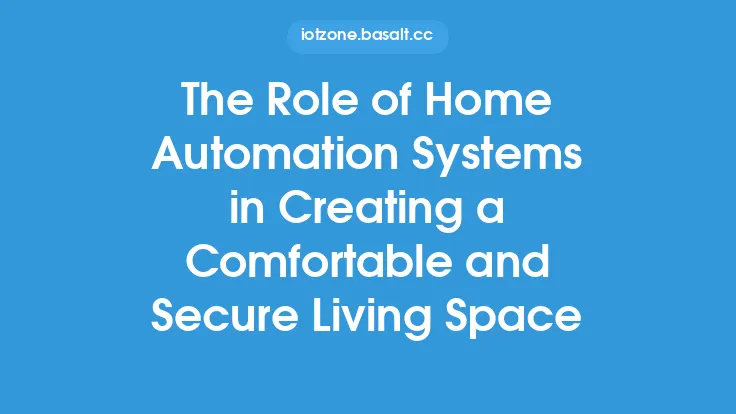Home automation systems have revolutionized the way we live, work, and interact with our living spaces. These systems enable homeowners to control and monitor various aspects of their homes, such as lighting, temperature, security, and entertainment, remotely or automatically. One of the key aspects of home automation systems is the type of connectivity they use, which can be broadly classified into three categories: wired, wireless, and hybrid. In this article, we will delve into the details of each type, exploring their advantages, disadvantages, and applications.
Wired Home Automation Systems
Wired home automation systems use physical cables to connect devices and controllers, providing a reliable and stable connection. These systems are often used in new construction projects or during major renovations, where it is easier to install cables and wiring. Wired systems offer several advantages, including faster data transfer rates, lower interference, and higher security. They are also less prone to signal loss or dropped connections, making them suitable for applications that require high reliability, such as security and surveillance systems. However, wired systems can be more expensive to install, especially in existing homes, and may require more labor and materials. Additionally, they can be less flexible, as devices are tied to specific locations and cannot be easily moved.
Wireless Home Automation Systems
Wireless home automation systems, on the other hand, use radio frequency (RF) or infrared (IR) signals to communicate between devices and controllers. These systems are more flexible and easier to install, as they do not require physical cables. Wireless systems are ideal for existing homes, where installing cables can be difficult or expensive. They also offer more flexibility, as devices can be moved or relocated without affecting the system. However, wireless systems can be more prone to interference, signal loss, or dropped connections, which can affect their reliability. They may also have lower data transfer rates and higher latency compared to wired systems. Despite these limitations, wireless systems have become increasingly popular, thanks to advances in technology and the development of standards such as Zigbee, Z-Wave, and Bluetooth.
Hybrid Home Automation Systems
Hybrid home automation systems combine the benefits of both wired and wireless systems, offering a flexible and reliable solution. These systems use a combination of wired and wireless connections to connect devices and controllers, providing a robust and scalable network. Hybrid systems can use wired connections for critical applications, such as security and surveillance, while using wireless connections for less critical applications, such as lighting and entertainment. This approach offers the best of both worlds, providing high reliability, flexibility, and scalability. Hybrid systems are ideal for large or complex homes, where a combination of wired and wireless connections is necessary to ensure reliable and efficient operation.
Comparison of Wired, Wireless, and Hybrid Systems
When choosing between wired, wireless, and hybrid home automation systems, several factors must be considered, including the size and complexity of the home, the type of applications, and the budget. Wired systems are ideal for new construction projects or major renovations, where cables and wiring can be easily installed. Wireless systems are suitable for existing homes, where installing cables can be difficult or expensive. Hybrid systems offer a flexible and reliable solution, combining the benefits of both wired and wireless systems. The following table summarizes the key advantages and disadvantages of each type of system:
| System Type | Advantages | Disadvantages |
|---|---|---|
| --- | --- | --- |
| Wired | Reliable, fast, secure | Expensive, inflexible |
| Wireless | Flexible, easy to install | Prone to interference, lower data transfer rates |
| Hybrid | Flexible, reliable, scalable | More complex, higher cost |
Applications of Home Automation Systems
Home automation systems can be applied to various aspects of a home, including lighting, temperature, security, entertainment, and energy management. These systems can be used to control and monitor lighting levels, temperature, and humidity, creating a comfortable and energy-efficient living space. They can also be used to secure the home, with features such as motion detection, video surveillance, and alarm systems. Additionally, home automation systems can be integrated with entertainment systems, such as audio and video equipment, to create a seamless and immersive experience.
Technical Considerations
When designing and implementing home automation systems, several technical considerations must be taken into account, including the type of connectivity, network topology, and device compatibility. The choice of connectivity type, whether wired, wireless, or hybrid, depends on the specific requirements of the application and the characteristics of the home. The network topology, including the layout of devices and controllers, must be carefully planned to ensure reliable and efficient operation. Device compatibility is also crucial, as devices from different manufacturers may use different protocols and standards, which can affect interoperability.
Conclusion
In conclusion, home automation systems offer a wide range of benefits, including convenience, energy efficiency, and enhanced security. The choice of system type, whether wired, wireless, or hybrid, depends on the specific requirements of the application and the characteristics of the home. By understanding the advantages and disadvantages of each type of system, homeowners can make informed decisions and create a smart and connected living space that meets their needs and enhances their quality of life. As technology continues to evolve, we can expect to see even more innovative and integrated home automation systems, offering new possibilities for comfort, convenience, and sustainability.





